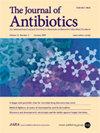In vitro assessment of the synergistic effects of cefotaxime, colistin, and fosfomycin combinations against foodborne resistant Escherichia coli and Salmonella isolates
IF 2.1
4区 医学
Q3 BIOTECHNOLOGY & APPLIED MICROBIOLOGY
引用次数: 0
Abstract
The emergence of multidrug-resistant pathogens, particularly β-lactam, colistin, and fosfomycin-resistant Escherichia coli and Salmonella, is a significant public health concern. This study evaluated the in vitro synergistic effects of antimicrobial combinations against these resistant isolates. Ten isolates that originated from retail chicken meat, including five E. coli and five Salmonella isolates, were tested against cefotaxime (CTA), fosfomycin (FOS), and colistin (COL), both individually and in combinations. Antimicrobial susceptibility was assessed using the broth microdilution method, and synergistic interactions were evaluated using checkerboard and time-killing assays. All isolates were multidrug-resistant (MDR) and were resistant to CTA, COL, and FOS. The checkerboard assay showed varying levels of synergy: two out of five E. coli isolates exhibited synergy with FOS-COL, while one E. coli isolates out of four isolates showed synergy with CTA-COL. No E. coli isolates showed synergy with FOS-CTA. For Salmonella, two out of five isolates exhibited synergy with both FOS-CTA and FOS-COL, while three out of four isolates showed synergy with CTA-COL. The time-killing assay confirmed these results, with the FOS-COL combinations showing synergy against both E. coli and Salmonella strains. Notably, the FOS-COL combination demonstrated bactericidal effects against E. coli, and all three combinations were bactericidal against Salmonella. The study highlights the potential of antimicrobial combinations, particularly FOS-COL, in combating MDR E. coli and Salmonella. These findings support the use of combination therapy as a promising strategy to in effectively treating multi-drug-resistant foodborne infections, ensuring better medical outcomes and enhanced food safety, warranting further investigation into their mechanisms and clinical applications.

头孢噻肟、粘菌素和磷霉素联合使用对食源性耐药大肠杆菌和沙门氏菌的体外协同作用评估。
多药耐药病原体的出现,特别是β-内酰胺、粘菌素和磷霉素耐药大肠杆菌和沙门氏菌的出现,是一个重大的公共卫生问题。本研究评估了抗菌药物组合对这些耐药菌株的体外协同作用。从零售鸡肉中分离出的10株分离物,包括5株大肠杆菌和5株沙门氏菌,分别对头孢噻肟(CTA)、磷霉素(FOS)和粘菌素(COL)进行了单独和联合检测。采用微量肉汤稀释法评价药敏,采用棋盘法和时间杀伤法评价协同作用。所有分离株均为多药耐药(MDR),并对CTA、COL和FOS耐药。棋盘试验显示出不同程度的协同作用:5株大肠杆菌中有2株与FOS-COL表现出协同作用,而4株大肠杆菌中有1株与CTA-COL表现出协同作用。没有大肠杆菌分离株与FOS-CTA有协同作用。对于沙门氏菌,5株分离株中有2株与FOS-CTA和FOS-COL均表现出协同作用,而4株分离株中有3株与CTA-COL表现出协同作用。时间杀伤试验证实了这些结果,FOS-COL组合对大肠杆菌和沙门氏菌菌株都显示出协同作用。值得注意的是,FOS-COL组合对大肠杆菌有杀菌作用,三种组合对沙门氏菌都有杀菌作用。这项研究强调了抗微生物药物组合,特别是FOS-COL在对抗耐多药大肠杆菌和沙门氏菌方面的潜力。这些发现支持使用联合治疗作为有效治疗多重耐药食源性感染的一种有希望的策略,确保更好的医疗结果和加强食品安全,值得对其机制和临床应用进行进一步研究。
本文章由计算机程序翻译,如有差异,请以英文原文为准。
求助全文
约1分钟内获得全文
求助全文
来源期刊

Journal of Antibiotics
医学-免疫学
CiteScore
6.60
自引率
3.00%
发文量
87
审稿时长
1 months
期刊介绍:
The Journal of Antibiotics seeks to promote research on antibiotics and related types of biologically active substances and publishes Articles, Review Articles, Brief Communication, Correspondence and other specially commissioned reports. The Journal of Antibiotics accepts papers on biochemical, chemical, microbiological and pharmacological studies. However, studies regarding human therapy do not fall under the journal’s scope. Contributions regarding recently discovered antibiotics and biologically active microbial products are particularly encouraged. Topics of particular interest within the journal''s scope include, but are not limited to, those listed below:
Discovery of new antibiotics and related types of biologically active substances
Production, isolation, characterization, structural elucidation, chemical synthesis and derivatization, biological activities, mechanisms of action, and structure-activity relationships of antibiotics and related types of biologically active substances
Biosynthesis, bioconversion, taxonomy and genetic studies on producing microorganisms, as well as improvement of production of antibiotics and related types of biologically active substances
Novel physical, chemical, biochemical, microbiological or pharmacological methods for detection, assay, determination, structural elucidation and evaluation of antibiotics and related types of biologically active substances
Newly found properties, mechanisms of action and resistance-development of antibiotics and related types of biologically active substances.
 求助内容:
求助内容: 应助结果提醒方式:
应助结果提醒方式:


